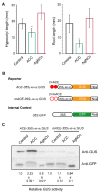An AC-Rich Bean Element Serves as an Ethylene-Responsive Element in Arabidopsis
- PMID: 32823972
- PMCID: PMC7465537
- DOI: 10.3390/plants9081033
An AC-Rich Bean Element Serves as an Ethylene-Responsive Element in Arabidopsis
Abstract
Ethylene-responsive elements (EREs), such as the GCC box, are critical for ethylene-regulated transcription in plants. Our previous work identified a 19-bp AC-rich element (ACE) in the promoter of bean (Phaseolus vulgaris) metal response element-binding transcription factor 1 (PvMTF-1). Ethylene response factor 15 (PvERF15) directly binds ACE to enhance PvMTF-1 expression. As a novel ERF-binding element, ACE exhibits a significant difference from the GCC box. Here, we demonstrated that ACE serves as an ERE in Arabidopsis. It conferred the minimal promoter to respond to the ethylene stress and inhibition of ethylene. Moreover, the cis-acting element ACE could specifically bind the nuclear proteins in vitro. We further revealed that the first 9-bp sequence of ACE (ACEcore) is importantly required by the binding of nuclear proteins. In addition, PvERF15 and PvMTF-1 were strongly induced by ethylene in bean seedlings. Since PvERF15 activates PvMTF-1 via ACE, ACE is involved in ethylene-induced PvMTF-1 expression. Taken together, our findings provide genetic and biochemical evidence for a new ERE.
Keywords: AC-rich element; Arabidopsis; ethylene response factor; ethylene-responsive element.
Conflict of interest statement
The authors declare no conflict of interest.
Figures




Similar articles
-
Transcription Factors PvERF15 and PvMTF-1 Form a Cadmium Stress Transcriptional Pathway.Plant Physiol. 2017 Mar;173(3):1565-1573. doi: 10.1104/pp.16.01729. Epub 2017 Jan 10. Plant Physiol. 2017. PMID: 28073984 Free PMC article.
-
Bean metal-responsive element-binding transcription factor confers cadmium resistance in tobacco.Plant Physiol. 2015 Mar;167(3):1136-48. doi: 10.1104/pp.114.253096. Epub 2015 Jan 26. Plant Physiol. 2015. PMID: 25624396 Free PMC article.
-
An ethylene-responsive enhancer element is involved in the senescence-related expression of the carnation glutathione-S-transferase (GST1) gene.Proc Natl Acad Sci U S A. 1994 Sep 13;91(19):8925-9. doi: 10.1073/pnas.91.19.8925. Proc Natl Acad Sci U S A. 1994. PMID: 8090746 Free PMC article.
-
Regulation of ethylene-induced transcription of defense genes.Plant Cell Physiol. 2000 Nov;41(11):1187-92. doi: 10.1093/pcp/pcd057. Plant Cell Physiol. 2000. PMID: 11092902 Review.
-
Genetic basis of ethylene perception and signal transduction in Arabidopsis.J Integr Plant Biol. 2008 Jul;50(7):808-15. doi: 10.1111/j.1744-7909.2008.00710.x. J Integr Plant Biol. 2008. PMID: 18713391 Review.
Cited by
-
Genome-wide identification and comprehensive analyses of NAC transcription factor gene family and expression analysis under Fusarium kyushuense and drought stress conditions in Passiflora edulis.Front Plant Sci. 2022 Aug 25;13:972734. doi: 10.3389/fpls.2022.972734. eCollection 2022. Front Plant Sci. 2022. PMID: 36092439 Free PMC article.
-
Physiological, Biochemical, and Transcriptomic Responses of Neolamarckia cadamba to Aluminum Stress.Int J Mol Sci. 2020 Dec 17;21(24):9624. doi: 10.3390/ijms21249624. Int J Mol Sci. 2020. PMID: 33348765 Free PMC article.
-
Metal-responsive elements confer cadmium response in Arabidopsis.Planta. 2023 Feb 11;257(3):53. doi: 10.1007/s00425-023-04093-4. Planta. 2023. PMID: 36773095
-
Thaumatin-like Protein (TLP) Genes in Garlic (Allium sativum L.): Genome-Wide Identification, Characterization, and Expression in Response to Fusarium proliferatum Infection.Plants (Basel). 2022 Mar 11;11(6):748. doi: 10.3390/plants11060748. Plants (Basel). 2022. PMID: 35336630 Free PMC article.
-
Identification and molecular evolution of the GLX genes in 21 plant species: a focus on the Gossypium hirsutum.BMC Genomics. 2023 Aug 22;24(1):474. doi: 10.1186/s12864-023-09524-w. BMC Genomics. 2023. PMID: 37608304 Free PMC article.
References
Grants and funding
LinkOut - more resources
Full Text Sources
Research Materials
Miscellaneous

